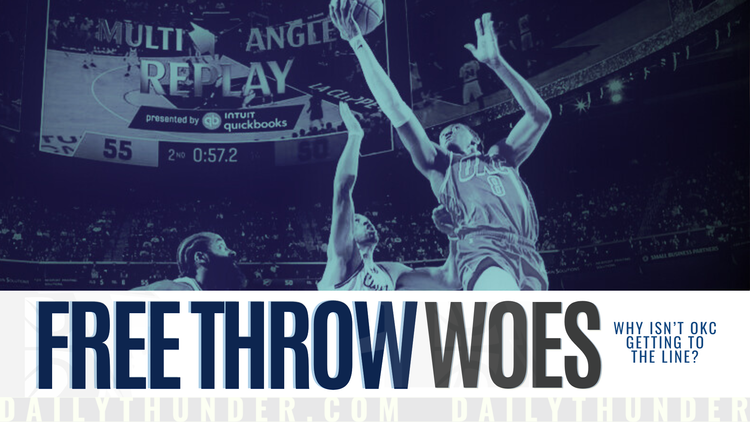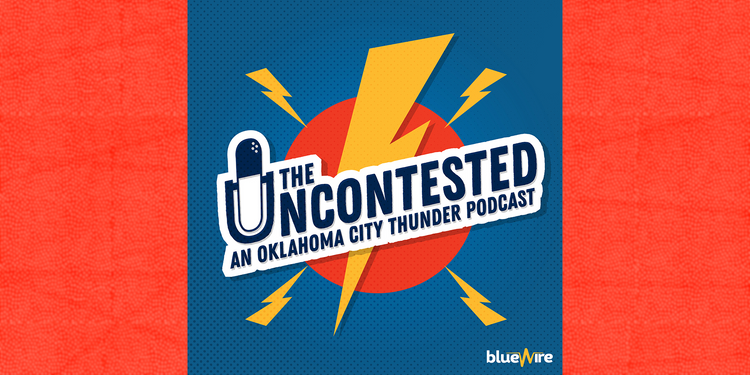The Best Is Yet to Come
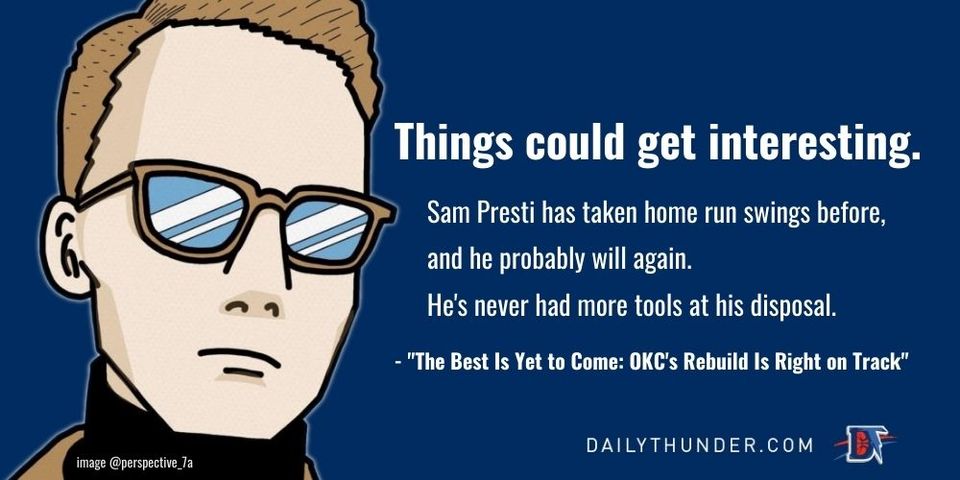
It’s been a while since we’ve been here.
Though OKC technically kicked off its rebuild in the summer of 2019, the Thunder were surprisingly frisky for the whole season. Then they traded away Chris Paul and completely reworked the roster this season. This is a rebuilding team, no doubt about it, and the Thunder are well positioned for the future.
That’s easy to see on the court, with young players like Shai Gilgeous-Alexander and Luguentz Dort showing out on a nightly basis. But it’s obvious when you look at the salary picture too.
A couple of seasons ago this was a capped-out team paying the repeater luxury tax, and the salary was so high that flexibility was limited. With the Thunder headed into the rebuild, they took a few specific steps to prepare for the future.
On Solid Ground
The Thunder’s preparation for a rebuild had several steps.
- Trade good older players on max contracts. As a general rule of thumb in the NBA, the older a player gets, the bigger his salary can be. Rebuilds require open salary slots and flexibility, so older max players have to go. The Thunder flipped Russell Westbrook, Paul George and Chris Paul for salary filler contracts, young players and assets.
- Stockpile assets. This team has an absurd number of draft picks, including pick swaps. Even the more protected first round picks may net second rounders down the line, and those can sometimes pay dividends. Look at Nikola Jokic, an MVP candidate this year. Or Tony Parker, a player many say was Sam Presti’s pick when he was with San Antonio.
- Clear cap space. The Thunder haven’t even been able to go under the luxury tax for a while, let alone under the salary cap. This year they’re so far under it that if nothing changes they will wind up slightly under the salary floor (the minimum payroll required of each team).
- Get short-term salary filler contracts that are tradable. Salary matching is an important part of trades, and an underrated one for many casual observers. Midsize and max salaries are crucial for matching in any trade that you don’t execute with cap space, and the Thunder have several veterans that fit this bill.
- Get some veterans and “second draft” young players you can rehabilitate. The Thunder did this with CP3, who reclaimed some of the respect and value he’d lost in a turbulent Rockets year. They did it with a disgruntled Dennis Schröder. Now they’re attempting it with guys like Al Horford and Justin Jackson.
Each of these steps has been executed in Oklahoma City, and executed well.
Wide Open Space
The Thunder’s salary picture for the next several years is remarkably clear.
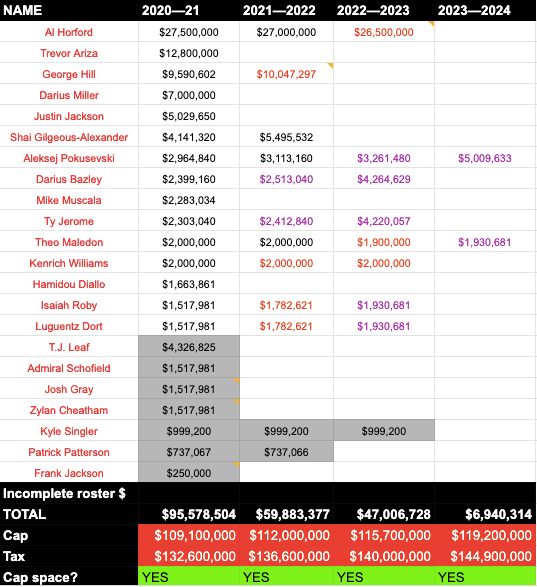
Some of these numbers (especially the salary cap for future years) are projected, but they will likely be fairly close.
As you can see, the Thunder this year are well below the cap. They have flexibility in trades and the ability to operate either above or below the salary cap depending on what the trade requires. This is because of cap holds — basically, a bit of creative bookkeeping that allows a team to keep a former player’s salary as a placeholder on their books. Everyone from Norris Cole to Nick Collison to Andre Roberson exists as a salary cap hold, which allows the Thunder to get above the cap if they want to.
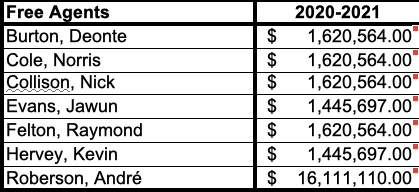
But the really interesting decision-making window for the Thunder begins next season.
If the Thunder don’t trade George Hill, they can waive him and get to $51,111,571 in salary. That’s not counting expiring player cap holds including Hamidou Diallo’s or holds for their draft picks, which will vary depending on where the Thunder finally wind up drafting. But it’s likely the Thunder can comfortably get a max slot next season.
They have enough draft capital in hand to offer a king’s ransom for any star player that comes on the market, or sit on that draft capital and take the players that fall to them. In a way, they’re in a very similar spot to where Danny Ainge and the Boston Celtics were a few years ago, and Boston got Jayson Tatum and Jaylen Brown out of that era.
Down to the Crossroads
The 2021 offseason is a crossroads offseason. The likely outcome is the Thunder stick to the draft, building slowly and developing young players as small-market teams often do. OKC doesn’t have the cachet as a market that San Francisco, Los Angeles or Miami does, and it doesn’t have the history to lean on like the Boston Celtics.
There is an interesting phenomenon building right now, though. Star players move between teams more than they ever have, whether they’ve hit free agency or not. And the Thunder have built up a reputation of doing right by their players in any trade requests. That matters. If the right opportunity came along OKC could swing for the fences again. It’s a risk, especially in this market. But Sam Presti has taken some home run swings before, and he probably will again.
It’s not an exaggeration to say that 2021 and 2022 will likely determine where this franchise goes for at least the next five years. How the Thunder draft, whether they use all their draft picks, and what they do in trades will determine their asset picture, the goal being to build up the asset base for another several years of title runs.
Come Tomorrow
We know the distant future is a promised land, full of converted picks and cap mechanics currently in the Thunder’s long-term treasure chest. But in the near future, the Thunder will likely continue to do what they’re doing for a while: The Process with less sexy branding. They may churn through players on the back end of the roster, looking for guys likely to stick (Isaiah Roby already looks like found money).
Trevor Ariza, Darius Miller, Justin Jackson and Mike Muscala all expire this year. Any or all of them could be bought out. Ariza is the most likely candidate, given that he hasn’t actually been with the team at any time this year. Miller is the next most likely.
The Thunder will likely continue to hunt for “second draft” players that need a change of scenery, and they have incentive to try to trade their vets that may still have tread on the tires. That includes Al Horford, Trevor Ariza and George Hill.
These players are available for trade. They are older and experienced. They’ve played on teams that have been contenders, and Ariza has a championship under his belt. It’s quite possible some teams will want to take a flier on them.
Horford is the least likely to be traded, mostly due to the size and length of his contract. He has two more seasons on his deal after this one, and the last year of his contract is still guaranteed for over $14 million. He’s still a good player but on the downslope of his career, and there’s a good chance he’ll be with the Thunder for at least one more season, if not two.
Keep an eye on expensive players who have underperformed and may come with a little added incentive. That might include players like the good but constantly injured Gary Harris, or an increasingly hobbled Blake Griffin. Maybe even OU’s own Buddy Hield, mired in mediocrity with the Kings. If a big salary move comes it’s likely to be this kind of trade.
Keep an eye also on young players who were touted coming into the draft but can’t get playing time on their teams. Presti went after highly drafted guys like Dion Waiters in the past and may again.
The Thunder’s future is unclear at this point. But young players are playing well, the cupboard is full of draft picks and they have plenty of salary flexibility for the future. It’s a good time to be a Thunder fan — and it looks like it will be for the foreseeable future, too.

